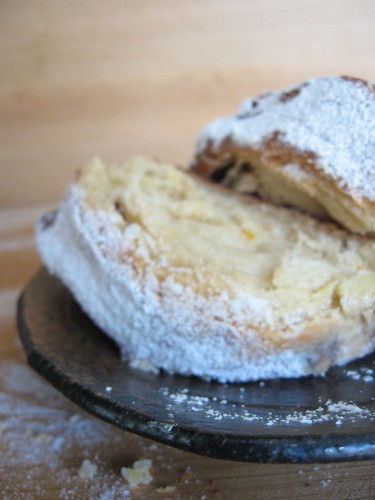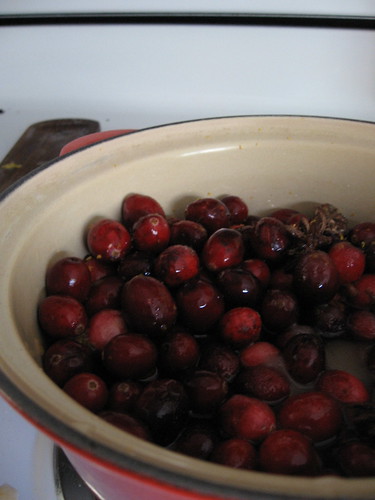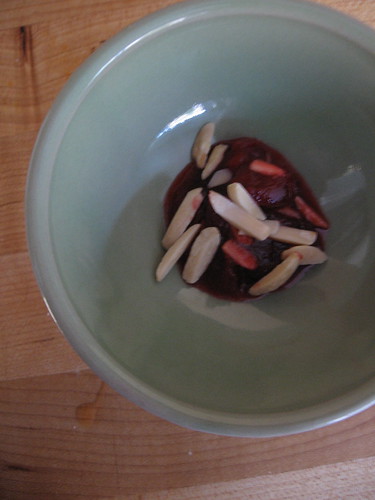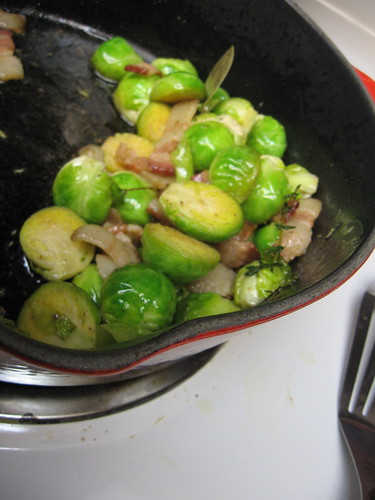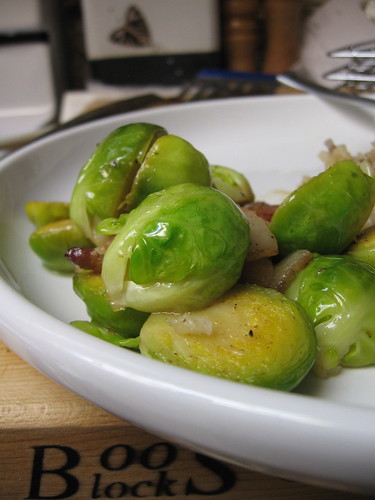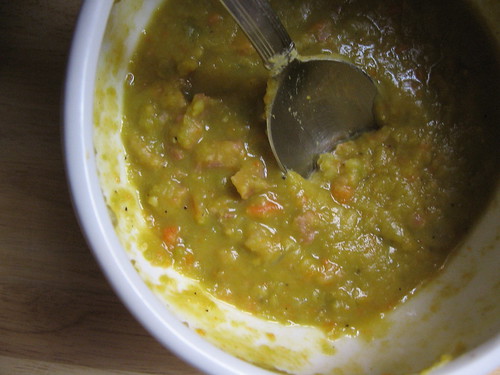I'm running behind schedule—and not just when it comes to blogging. My parents came to visit, which was fantastic ... but wow. Christmas is one week from tomorrow.
I'm behind on my blogging, to be sure, and my blog reader is about to burst from all the unread posts, but that's the least of my worries.
I'm behind on gifts—there are some downsides to focusing as much as possible on hand made items. I'm behind on knitting, on wrapping, and on so much as thinking about stocking stuffers. And
until yesterday, I had not made a single Christmas cookie.
How is that possible? I'm usually the queen of Christmas cookies, with half a dozen varieties baked up before the second week of December begins. I may have a party to go to this weekend, but I think I will be stocking up on butter, buying another bag of sugar, and dirtying every baking sheet I own. Several times.
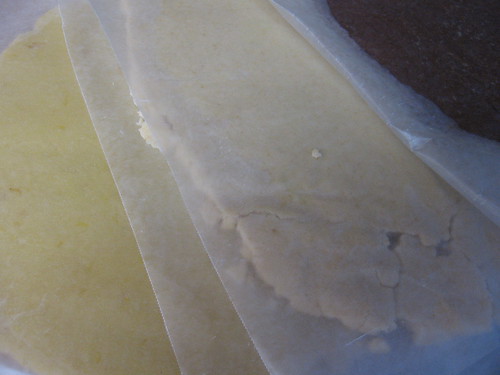
Luckily for my blog (and for my belly), I made shortbread last night. Shortbread is one of my favorite kinds of cookie, and one that I rarely make after December. A simple, sugar-flour-butter cookie—complimented with a dash of vanilla and a sprinkle of salt—is all that anyone should ask for, but what can I say? My favorite thing about shortbread isn't the rich butter or the melt in your mouth sandy texture (no wondering why these are called
sablées in France), but rather the endless tweaking that I can do to a recipe.
Last year I became more than a little bit obsessed with dark chocolate-drizzled cardamom shortbread, but I'm a fickle girl, and they haven't even crossed my mind. This year, it's time for something old, and something new; for tradition and experimentation. Yesterday afternoon, after recovering from a vicious migraine, I made up for lost time by making four different batches of shortbread. One I'm saving for later, but I'll show three of them to you today.
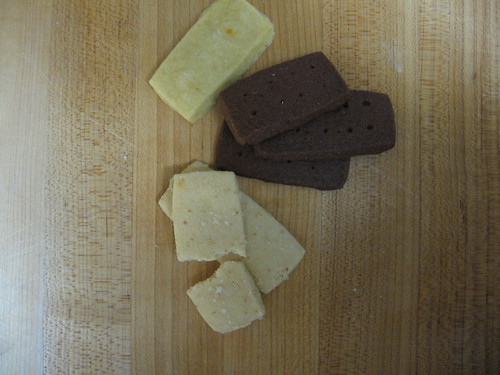
It's an unassuming trio of little rectangles—no fancy shapes for the humble shortbread in my house—of brown butter and salt, Mexican chocolate, and Meyer lemon. Each delights me in different ways, but I'm going to start, as I so often do, with chocolate.
I was inspired by the Salt & Pepper Cocoa Shortbreads from Dorie Greenspan's lovely "
Baking: From my Home to Yours," but after several hours pondering black pepper (with chocolate? without chocolate? with lemon instead of chocolate?), I scratched that idea and went with a classic chocolate-cinnamon combination. I think these would be ideal with Ceylon, or "true" cinnamon (see my polemic on cinnamon at the bottom of
this post), but I spaced out (I blame the vestiges of migraine) and used cassia. No matter - these are crumbly, intensely chocolaty, and jolted by the shot of spice.
The most important things about shortbread are the butter and the method of mixing them together. While you don't need to bankrupt yourself buying the best butter available, it should definitely taste delicious just by itself. I mix my shortbread by hand only—it lowers the chances of over mixing and dirties nothing more than one bowl and one spoon, and it gives me an arm workout too. Use butter that is softened but still slightly firm—not at all oily—or else you'll lose that sandy texture. Also, don't beat the butter and sugar like you would for, say, chocolate chip cookies, or you'll end up with a cookie that will puff and then, most likely, collapse when cool. Five minutes and a little elbow grease will produce a perfect, light-yet-rich, crumbly-but-melting cookie that you won't be able to keep your hands off. I should know—I ate some for breakfast this morning.
 Mexican Chocolate Shortbread Cookies
Mexican Chocolate Shortbread Cookies
These cookies are not too sweet—a common occurrence with my desserts, to be honest—so if you like sweeter cookies, you may want to add a few extra tablespoons of sugar. These cookies would be fantastic with a café au lait or an espresso, but they stand alone just fine. An added bonus for those with cookie thieves in the house: cut and bake the ragged ends, reserving the pretty pieces for gift boxes.
1 ½ cups unbleached flour
6 tablespoons cocoa powder
1 teaspoon cinnamon (or cassia, if you prefer)
½ teaspoon salt
1 cup (two sticks) good-quality unsalted butter, mostly softened
⅖ cups confectioners' sugar
1 teaspoon vanilla extract
Mix the flour, cocoa, cinnamon, and salt in a medium bowl and set aside.
Break the butter up with a wooden spoon in a large bowl, then stir briskly to loosen. Add the sugar and beat briefly until well combined, with no lumps. Add the vanilla and beat very briefly, until just combined.
Dump in the flour mixture and carefully stir until just combined—watch out here to avoid flour explosions that dump your carefully measured dry goods onto the floor (ask me how I know this).
Place a piece of waxed paper on a large board or clean counter. Dump the dough onto the paper, cover with another piece of paper, and quickly roll out the dough about ¼ inch thick (for me, this made a square roughly eight inches by fourteen. Transfer to a baking sheet and refrigerate at least two hours, but the longer the better (cover the entire sheet with plastic wrap if you will chill overnight.
Preheat the oven to 350˚F and place racks in top and bottom third of the oven. Line two baking sheets with parchment or Silpat. Remove the cookies from the oven, peel off the top layer of waxed paper and cut into 1 inch by 3 inch fingers. Using a thin spatula, transfer to the sheets.
Bake 12-14 minutes, swapping sheets midway through the baking time. The cookies will still be a little soft when gently pressed with a finger, but not mushy. Transfer to racks and let cool.
These cookies will keep in a tin for 4 or 5 days at room temperature; alternatively, wrap tightly and freeze for up to two months.
Makes about 3 dozen (plus the ugly bits)

